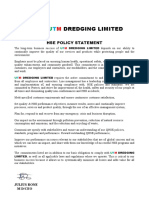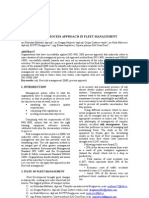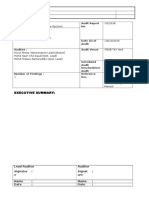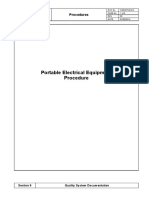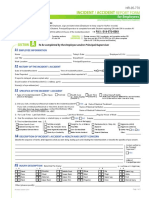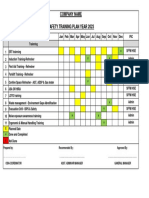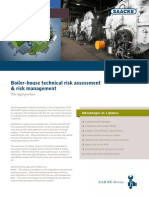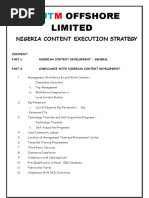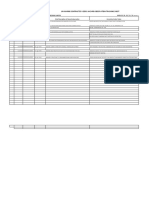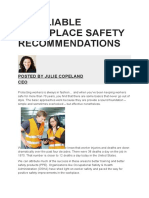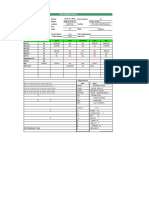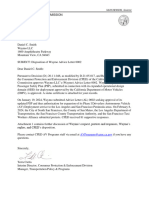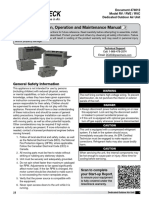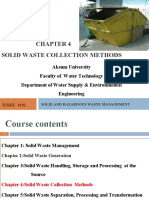Utm Dredging Limited: Health & Safety Management System
Utm Dredging Limited: Health & Safety Management System
Uploaded by
VICTORCopyright:
Available Formats
Utm Dredging Limited: Health & Safety Management System
Utm Dredging Limited: Health & Safety Management System
Uploaded by
VICTOROriginal Title
Copyright
Available Formats
Share this document
Did you find this document useful?
Is this content inappropriate?
Copyright:
Available Formats
Utm Dredging Limited: Health & Safety Management System
Utm Dredging Limited: Health & Safety Management System
Uploaded by
VICTORCopyright:
Available Formats
Page No 1-3
UTM DREDGING HEALTH & SAFETY Effective Date: 2019
LIMITED MANAGEMENT SYSTEM Document No:
UTM/GF/HSE-
FDRP-01
FAULT/DEFECT REPORTING PROCEDURE
VICTOR TASIE
Preparation:
(HSSE)
JULIUS RONE
Approved by:
MD/CEO
UTM DREDGING LIMITED believes in the health and safety of our drivers and passengers. To
ensure this all vehicle faults and defects must be reported effectively and communicated to the
appropriate Manager as soon as they are identified so they can be acted upon in a timely manner.
WHO TO CONTACT:
If passengers are on board when a fault/ defect is identified, or the fault / defect will cause a delay in
the service, DRIVERS / MASTER must contact their Operations Manager.
If NO passengers are on board when a fault/ defect is identified and the fault / defect will not cause a
delay in the service, DRIVERS/MASTER must contact the Fleet Maintenance Manager / Workshop
Manager .
Please note: The time frame for which faults/ defects must be reported will change with the severity
of the fault or defect.
e.g - An interior light malfunctioning VS a wheel falling off.
Faults are vehicle issues that do not affect safety, some examples are:
• Blinker not cancelling
• Door rattle
Defects are vehicle issues that do affect safety, some examples are:
• Air pressure not building up
• Park brake not holding
Vehicle faults and defects are identified in the following ways:
• At times of scheduled maintenance
• By a vehicle safety inspection
• By drivers during the Pre-Departure / End of Shift check
• Through roadworthy inspections
Faults
Any faults or body damage must be recorded in the Faults Folder which is located in the staff room of
every depot. Faults must also be verbally reported as soon as practicable to the Fleet Maintenance
Manager / Workshop Manager or the Dubbo Operations Manager for Northern NSW employees.
If a driver identifies a 'fault’ during a pre-departure inspection, the driver must:
• Verbally notify the appropriate Manager.
• Record all details of the Fault in the “Faults Folder.”
Once the appropriate Manager is informed of the fault they must follow the below steps:
• Establish whether the vehicle is roadworthy and able to continue the journey.
• List the fault on the Maintenance Register.
• Prioritise and schedule each fault for repairs.
Any Defects must be recorded in the defect report book which is located in every vehicle. Defects
must be reported as soon as practicable to either the Fleet Maintenance Manager / Workshop
Manager.
If a DRIVER/MASTER identifies a 'defect' during a pre-departure inspection, the DRIVER/MASTER
must:
• Not operate the VEHICLE/VESSEL
• Immediately notify the appropriate Manager .
• Record all details of the Defect in the “Defect Report Book” (located in each vehicle).
• Record the Defect Book Number on the Daily/ Shift Check Book.
• Take appropriate steps to ensure that the vehicle is not used by another driver .
Once the appropriate Manager is informed of the defect they must follow the below steps:
• Organise the driver to use an alternative bus until such time as the vehicle is roadworthy.
• Ground the vehicle until such time as it is made roadworthy. A grounded vehicle is
identified by a “Do Not Use This Vehicle” sign on the dashboard.
• Quarantine the keys.
• List the defect on the Maintenance Register and ensure it remains un -used until such
time as the vehicle is roadworthy.
• When defects are fixed the appropriate defect clearance document must be filed with
the defect report.
DRIVER/MASTER receive confirmation of all defects/faults submitted as well as information relation
to the 'fix'.
Created By: VICTOR TASIE Date Of Effect: 1st December 2019 Version: 01
Authorised By: TERENCE DAFIAGHOR Last Reviewed: 00 Name: Fault/ Defect Reporting Procedure
You might also like
- BT Tyro LHE150 - Spare Part Book 201912 TMHIDocument37 pagesBT Tyro LHE150 - Spare Part Book 201912 TMHIOficina Base Anápolis0% (2)
- Instruction InstallationDocument7 pagesInstruction InstallationbryadNo ratings yet
- What Is Musta'ed & How To UseDocument4 pagesWhat Is Musta'ed & How To UseWaqar KhanNo ratings yet
- Module 1 The Nosa Integrated 5 Star SystemDocument2 pagesModule 1 The Nosa Integrated 5 Star SystemGodfrey TamaneNo ratings yet
- Behavior Based Safety ProcedureDocument11 pagesBehavior Based Safety ProcedureVICTOR100% (3)
- Schematic Rockola Expandable 2022-11-18Document1 pageSchematic Rockola Expandable 2022-11-18Linkon BiswasNo ratings yet
- Professional SummaryDocument3 pagesProfessional SummaryVijay LS SolutionsNo ratings yet
- Safety Environmental Management System (Sems) Standards ManualDocument26 pagesSafety Environmental Management System (Sems) Standards ManualrwerwerwNo ratings yet
- Familiarisation Crew MembersDocument2 pagesFamiliarisation Crew MembersVICTORNo ratings yet
- Corporate Social Responsibility Policy 01Document5 pagesCorporate Social Responsibility Policy 01VICTORNo ratings yet
- Hse Goals and TargetsDocument4 pagesHse Goals and TargetsVICTOR100% (4)
- Hse Policy StatementDocument1 pageHse Policy StatementVICTORNo ratings yet
- Suspension BridgeDocument39 pagesSuspension Bridgeayushj100% (2)
- Site Shutdown ChecklistDocument1 pageSite Shutdown ChecklistRPM28XI0% (1)
- Fork Lift Daily Check: (Only For FL Operated by Batery)Document1 pageFork Lift Daily Check: (Only For FL Operated by Batery)Martin CabelloNo ratings yet
- HSE 05-011a Daily Inspection Register For Forklift TrucksDocument1 pageHSE 05-011a Daily Inspection Register For Forklift TrucksQuentin KlynsmithNo ratings yet
- Standard Operating ProcedureDocument55 pagesStandard Operating Procedureboy tryadi100% (1)
- Risk and Process Approach in Fleet ManagementDocument7 pagesRisk and Process Approach in Fleet Managementmalbasic75100% (1)
- Health & Safety Incident Investigation FormDocument3 pagesHealth & Safety Incident Investigation FormKen AriNo ratings yet
- Guidance Material OM BVLOS Drone Operations Over Sparsely Populated Areas - v1Document10 pagesGuidance Material OM BVLOS Drone Operations Over Sparsely Populated Areas - v1prasenjitdey786No ratings yet
- Guide To Injury ClassificationDocument2 pagesGuide To Injury ClassificationWilliams AmadiNo ratings yet
- Creating A Culture Of Safety A Complete Guide - 2020 EditionFrom EverandCreating A Culture Of Safety A Complete Guide - 2020 EditionNo ratings yet
- (SOP09) LUS-HSE-SP2-442-001.02 - HSE Training ProcedureDocument8 pages(SOP09) LUS-HSE-SP2-442-001.02 - HSE Training ProceduregiovadiNo ratings yet
- PSC HANDS-FREE :oil & Gas Health Safety Environment (HSE)Document12 pagesPSC HANDS-FREE :oil & Gas Health Safety Environment (HSE)Hands-Free Safety PSCNo ratings yet
- Fork Lift Truck Daily ChecklistDocument4 pagesFork Lift Truck Daily ChecklistRameeSahibaNo ratings yet
- Assessment: #0005 Sms (Ism Code)Document7 pagesAssessment: #0005 Sms (Ism Code)KnezMarinNo ratings yet
- Critical Success FactorsDocument1 pageCritical Success Factorsvishmala25No ratings yet
- QMS11403-1 20160705 Joining-Instruction BOSIET EDocument5 pagesQMS11403-1 20160705 Joining-Instruction BOSIET EmashanghNo ratings yet
- Audited Department: Audit Report No. Audit Team:: Lead Auditor Auditor Signatur E: Signat UreDocument2 pagesAudited Department: Audit Report No. Audit Team:: Lead Auditor Auditor Signatur E: Signat UreZamir MustafaNo ratings yet
- Vehicle Tracking Policy - CMT Approved 01.09.16Document6 pagesVehicle Tracking Policy - CMT Approved 01.09.16sethup_1No ratings yet
- 2020-02-16 Site Safety Notice (Fog Alert)Document2 pages2020-02-16 Site Safety Notice (Fog Alert)Vignesh RamalingamNo ratings yet
- Competency Assessment Form - New Vendor RegistrationDocument9 pagesCompetency Assessment Form - New Vendor Registrationmadhusri002No ratings yet
- Oman HSECultureDocument19 pagesOman HSECulturesamsoom1972No ratings yet
- SHE-ECP-09-013 Portable Electrical Equipment Procedure Rev02Document5 pagesSHE-ECP-09-013 Portable Electrical Equipment Procedure Rev02grantNo ratings yet
- Safety, Health & Environment Policy: Purpose ExpectationsDocument1 pageSafety, Health & Environment Policy: Purpose ExpectationsWibowo ArieNo ratings yet
- F-OPN-07-17 Property Gate Pass (Rev. 00)Document2 pagesF-OPN-07-17 Property Gate Pass (Rev. 00)diane laine loretoNo ratings yet
- Portfolio in Maintenance and RepairDocument12 pagesPortfolio in Maintenance and RepairCarlos Joshua Oreo100% (1)
- Workplace Inspection Checklist WorkshopDocument3 pagesWorkplace Inspection Checklist WorkshopDoaa GamalNo ratings yet
- SLB DrivingDocument1 pageSLB DrivingmashanghNo ratings yet
- One DTI QMS Audit ReportDocument209 pagesOne DTI QMS Audit ReportJonathan LarozaNo ratings yet
- Employee Vehicle AccidentDocument2 pagesEmployee Vehicle AccidentlintangNo ratings yet
- HSE-005-PR Vehicle and Driver Safety PDFDocument6 pagesHSE-005-PR Vehicle and Driver Safety PDFCobbinah MarkNo ratings yet
- Account and Finance Departmental ObjectiveDocument7 pagesAccount and Finance Departmental ObjectiveVICTORNo ratings yet
- CSP-4.4.3 Workers Participation and ConsultationDocument5 pagesCSP-4.4.3 Workers Participation and ConsultationYves MouroufieNo ratings yet
- SAMPLE Safety Training Plan 2023Document1 pageSAMPLE Safety Training Plan 2023Yusnor YunusNo ratings yet
- Standard Operating Procedure: Vehicle and Equipment MaintenanceDocument3 pagesStandard Operating Procedure: Vehicle and Equipment MaintenanceLian Mae SanchezNo ratings yet
- Guidance For Air Operators in Establishing A Flight Safety Document System PDFDocument23 pagesGuidance For Air Operators in Establishing A Flight Safety Document System PDFgasparusNo ratings yet
- Guidelines For The Control of Drug and Alcohol Onboard ShipDocument40 pagesGuidelines For The Control of Drug and Alcohol Onboard ShipBaymax Thor100% (1)
- GE ENERGY Quality Manual Oct 2010Document24 pagesGE ENERGY Quality Manual Oct 2010e2ycNo ratings yet
- Heavy Equipment Operation 2325 SGDocument20 pagesHeavy Equipment Operation 2325 SGpjeongwoo.onlyNo ratings yet
- Qms MRM Input 2015Document1 pageQms MRM Input 2015venkatesanNo ratings yet
- CartridgeSelectionPoster English HRDocument1 pageCartridgeSelectionPoster English HRTg TarroNo ratings yet
- TBT Machine GuardingDocument1 pageTBT Machine GuardingAlfred Harvey ElacionNo ratings yet
- Daily HSE Statistics Report APE 2024Document22 pagesDaily HSE Statistics Report APE 2024HITRPM22No ratings yet
- ISO 14001 Certification ChecklistDocument4 pagesISO 14001 Certification ChecklistEyob SNo ratings yet
- Health and Safety Policy OrientationDocument3 pagesHealth and Safety Policy OrientationKarn SandhuNo ratings yet
- Safety CultureDocument20 pagesSafety Culturepersonalmail_20011078No ratings yet
- Pressure Systems Safety Ifluids Engineering ServicesDocument7 pagesPressure Systems Safety Ifluids Engineering ServicesRaagul SanthanamNo ratings yet
- IDSE Unit 1 Sample ExamDocument2 pagesIDSE Unit 1 Sample ExamKannan Jagan100% (2)
- Golden Rules Meeting Pack - FVDocument16 pagesGolden Rules Meeting Pack - FVSilviu Daniel BoldeaNo ratings yet
- National Lifting Operations Management System 2021Document44 pagesNational Lifting Operations Management System 2021ALAMEERNo ratings yet
- SAACKE UK Boiler-House Technical Risk AssessmentDocument2 pagesSAACKE UK Boiler-House Technical Risk Assessmentashnee sewockNo ratings yet
- Green Procurement Presentation by Dana Arnold OFEEDocument94 pagesGreen Procurement Presentation by Dana Arnold OFEEWildan Irfansyah100% (1)
- Application For Permit To Work Permit No:: (Work Shall Not Commence Until Stage 1 To Stage 3 For Contract Jobs Is DultDocument3 pagesApplication For Permit To Work Permit No:: (Work Shall Not Commence Until Stage 1 To Stage 3 For Contract Jobs Is DultReaz UddinNo ratings yet
- Client Feedback FormDocument3 pagesClient Feedback Formndayiragije JMVNo ratings yet
- Break Down MaintenanceDocument9 pagesBreak Down MaintenanceVinitha Vasudevan100% (1)
- Surfer Vessel Inspection Form - V2Document12 pagesSurfer Vessel Inspection Form - V2VICTOR100% (1)
- NON CONFORMITY Module 1Document13 pagesNON CONFORMITY Module 1VICTORNo ratings yet
- Boldbee Enterprises Letter HeadDocument1 pageBoldbee Enterprises Letter HeadVICTORNo ratings yet
- Behavior Based Safety ProgramDocument2 pagesBehavior Based Safety ProgramVICTORNo ratings yet
- Nigeria Content Execution Strategy 01Document28 pagesNigeria Content Execution Strategy 01VICTORNo ratings yet
- Mutual Rescission and Release Agreement PolicyDocument2 pagesMutual Rescission and Release Agreement PolicyVICTORNo ratings yet
- Chief Engineers Internal HandoverDocument4 pagesChief Engineers Internal HandoverVICTORNo ratings yet
- Check List Pre Transfer BunkerDocument2 pagesCheck List Pre Transfer BunkerVICTORNo ratings yet
- Risk Assessment For Defective Fifi SystemDocument5 pagesRisk Assessment For Defective Fifi SystemVICTORNo ratings yet
- Un Marine Contracted Vessel Hazard Tracking Form 03 11 !9Document4 pagesUn Marine Contracted Vessel Hazard Tracking Form 03 11 !9VICTORNo ratings yet
- Safe Storage of Hazardous Chemicals PolicyDocument3 pagesSafe Storage of Hazardous Chemicals PolicyVICTORNo ratings yet
- Inspection Report of Reefer Container at Abo Offshore 0012Document2 pagesInspection Report of Reefer Container at Abo Offshore 0012VICTORNo ratings yet
- Dredging Limited Safety Stand Down Meeting On Fire Incident On Board Utw ChallengerDocument2 pagesDredging Limited Safety Stand Down Meeting On Fire Incident On Board Utw ChallengerVICTORNo ratings yet
- Vessel Assurance QuestionnaireDocument4 pagesVessel Assurance QuestionnaireVICTORNo ratings yet
- 10 Reliable Workplace Safety RecommendationsDocument6 pages10 Reliable Workplace Safety RecommendationsVICTORNo ratings yet
- Fraud & MalpracticeDocument1 pageFraud & MalpracticeVICTOR100% (1)
- Requisition FormDocument1 pageRequisition FormVICTORNo ratings yet
- Hse Vision StatementDocument1 pageHse Vision StatementVICTORNo ratings yet
- Quality Assurance Policy: Dredging Limited Endorses Benchmarking Amongst Its Personnel ToDocument1 pageQuality Assurance Policy: Dredging Limited Endorses Benchmarking Amongst Its Personnel ToVICTORNo ratings yet
- Workplace Safety Meeting Minutes TemplateDocument3 pagesWorkplace Safety Meeting Minutes TemplateVICTOR100% (1)
- PR1171-Part IIDocument22 pagesPR1171-Part IIVICTORNo ratings yet
- How To Conduct Workplace InspectionsDocument6 pagesHow To Conduct Workplace InspectionsVICTORNo ratings yet
- DMR 14th APRIL.2019Document2 pagesDMR 14th APRIL.2019VICTORNo ratings yet
- Part 2 Twentieth Century Naval Dockyards Devonport and Portsmouth Characterisation ReportDocument52 pagesPart 2 Twentieth Century Naval Dockyards Devonport and Portsmouth Characterisation ReportToby ChessonNo ratings yet
- s3 - Single Wire SignallingDocument197 pagess3 - Single Wire Signallingsrdenc fzrNo ratings yet
- Emergency Response Drill Scenario - Collision & Damage Control (Cat - Abaja)Document3 pagesEmergency Response Drill Scenario - Collision & Damage Control (Cat - Abaja)Alok SinghNo ratings yet
- Airport - Part 2 - Going Through SecurityDocument7 pagesAirport - Part 2 - Going Through SecurityRaphael Ribeiro NetoNo ratings yet
- UCLA MLP Scavenger HuntDocument1 pageUCLA MLP Scavenger HuntJesus Tapia-VillegasNo ratings yet
- Tanzania - A Guide To Road Safety AuditingDocument34 pagesTanzania - A Guide To Road Safety AuditingFazelah YakubNo ratings yet
- Waymo California Public Utilities Commission Approval To Expand To Los AngelesDocument10 pagesWaymo California Public Utilities Commission Approval To Expand To Los AngeleszacharydviscontiNo ratings yet
- MMDA Releases Guidelines On TowingDocument12 pagesMMDA Releases Guidelines On TowingMarylyn Joy PamatigaNo ratings yet
- Ad428 Gumallaoi Judelle v. Ar Programming 4aDocument55 pagesAd428 Gumallaoi Judelle v. Ar Programming 4aLuwella GumallaoiNo ratings yet
- The Sarah Joe MysteryDocument3 pagesThe Sarah Joe MysteryLords mobileNo ratings yet
- D. Brake SystemDocument6 pagesD. Brake Systemanang waskitoNo ratings yet
- 474612rv Rve IomDocument44 pages474612rv Rve IomstronginternacionalhondurasNo ratings yet
- Mercedes Technical Training 327 Ho 09 SBC WJB 03-05-04Document5 pagesMercedes Technical Training 327 Ho 09 SBC WJB 03-05-04patricia100% (54)
- Kanchan Kanya Sleeper Class (SL) : WL WLDocument2 pagesKanchan Kanya Sleeper Class (SL) : WL WLSyed ShadabNo ratings yet
- DENSO Installation Note Compressor 55E.SL ENDocument2 pagesDENSO Installation Note Compressor 55E.SL ENFreddyNo ratings yet
- YBCG (Gold Coast) : General InfoDocument10 pagesYBCG (Gold Coast) : General InfoA340_600100% (1)
- Ch2.0 Geometric Design of HighwaysDocument38 pagesCh2.0 Geometric Design of HighwaysAmanuel AshenafiNo ratings yet
- SBJD Rnp-Z-Rwy-18 Iac 20210520Document1 pageSBJD Rnp-Z-Rwy-18 Iac 20210520Thiago MirandaNo ratings yet
- Chapter 4 WSEE-4192Document41 pagesChapter 4 WSEE-4192Esayas DerejeNo ratings yet
- NGUBANE V SOUTH AFRICAN TRANSPORT SERVICES (1991) 4 All SA 22 (AD)Document11 pagesNGUBANE V SOUTH AFRICAN TRANSPORT SERVICES (1991) 4 All SA 22 (AD)equinox420No ratings yet
- Latest Berthing-Report MundraDocument2 pagesLatest Berthing-Report MundraamitNo ratings yet
- Satyaprakash .Document491 pagesSatyaprakash .aecNo ratings yet
- NestDocument1 pageNestrichie RicNo ratings yet
- ME 301-Midterm-2022-2-PrintDocument1 pageME 301-Midterm-2022-2-PrintGintoki SakataNo ratings yet
- Mark Paul ChuDocument2 pagesMark Paul ChuJohn Mc Ron D. HaliliNo ratings yet
- B1 RevisionDocument17 pagesB1 RevisionPierre BrocasNo ratings yet












